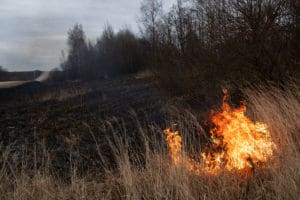Are you planning to build a home on rural property? Depending on the setting, local zoning laws and regulations could impact where you can place structures on the land. Fuelbreak laws in Oregon impact rural property owners and are designed to protect property against the dangers of wildfires. If you’re planning to build on land containing or bordered by trees or brush, you should contact experts like Richard Stevens & Associates to learn about all the zoning regulations that will impact your development plans.
 What is a fuelbreak?
What is a fuelbreak?
Fuelbreaks are intended to create a barrier to reduce the rate of spread and intensity of a traveling wildfire. By slowing it down, the fuelbreak provides an area for fire suppression teams to safely manage the fire before it approaches a home, property, animals, or other structures.
The Jackson County Development Services division provides this information to explain fuelbreaks:
“The Wildland Interface Fire Committee has developed guidelines for fire safety in a wildfire hazard area. A fuelbreak is an area of reduced and/or managed vegetation designed to slow and minimize fire intensity. A 100-foot fuelbreak is required around all new structures in any resource zone (FR, WR, EFU and OSR), and rural residential zones (RR-5, RR-10 and RR-00) that are outside of an Urban Growth Boundary (UGB) or Urban Containment Boundary (UCB).”
What are the requirements to be considered a fuelbreak?
According to Oregon law (OAR 629-044-1085), fuelbreaks are natural or modified sections of land where flammable material either doesn’t exist or has been cleared or cut down to slow down the spread of fire. Some ways you can accomplish this include:
- Fill the area with non-flammable ground cover. This could be asphalt, bare soil, clover, concrete, green grass, ivy, mulches, rock, succulent ground cover, wildflowers, or similar material.
- Keep dry grass cut to a maximum of 4 inches in height.
- Maintaining shrubbery, trees, and plants in the zone that are kept watered and green, free of dead material, and trimmed so they don’t spread fire from ground to canopy.
More information about Oregon’s fuelbreak law can be found at this link.
Need to figure out if you’re property is impacted by fuelbreak laws in Oregon?
Before you invest in a parcel of property or decide to further develop your own, it’s essential to consult with professionals who can walk you through all of the land use issues you need to consider. At Richard Stevens & Associates, we specialize in assisting our clients with obtaining rural and urban land use permits. We can help you consider the pros and cons of different options so you’ll feel confident about your final decision. Contact us today to learn more about how we can help you achieve your goals.

 What is a fuelbreak?
What is a fuelbreak?